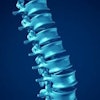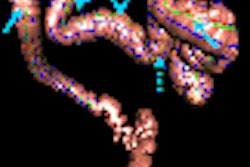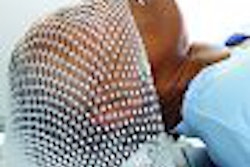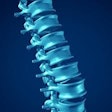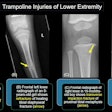Knee arthrography is generally used as the first-line imaging study before patients move on to MR or CT arthrography. The lateral patellofemoral approach is most commonly used for knee puncture, but it is a painful procedure and not always technically successful. Instead, French musculoskeletal radiologists have used an anterior approach for knee arthrography to good effect, and discussed their technique in the January issue of Radiology.
"The anterior approach for knee arthrography has been used for 30 years in our department (instead of the lateral patellofemoral approach)," wrote Dr. Thomas Moser and colleagues at Strasbourg University Hospital in Strasbourg, France (Radiology, January 2008, Vol. 246:1, pp. 193-199).
For this prospective study, the team enrolled 159 patients referred for internal derangement of the knee. Patients were supine on the fluoroscopy table with a bolster under the knee slated for injection. An anterior paramedian route was used in 86 patients with the knee flexed at 60°. A 20-gauge, 45-mm intravenous cannula was placed lateral to the patellar ligament and directed upward. An anterolateral route was used in 73 patients with the knee flexed at 90°, and a 21½-gauge, 40-mm needle was introduced and directed posteriorly and slightly medially. In all cases, 10 mL of iopamidol (370 mg/mL iodine concentration) were injected.
After joint mobilization, x-rays were obtained and CT arthrography was done. A technical success score on a scale of 1 (no needle repositioning; smooth injection) to 5 (extra-articular injection of > 5 mL) was self-reported by the authors. The group also looked at the relationship among absolute pain, technical success, age, and body mass index (BMI).
According to the results, the technical success score was 1.36 ± 0.84. Both the absolute pain and relative pain were minimal for the anterior approach, although absolute pain was significantly lower for the anterolateral route than for the paramedian one, the authors noted.
"A potential explanation for the difference could be that the anterior paramedian route systematically transgresses the infrapatellar fat pad, which has a rich nerve supply," they explained. "The fat pad is only minimally crossed with the anterolateral route."
The authors acknowledged some limitations to the study. They did not do a direct comparison between their approach and the classic patellofemoral one. Also, a different needle size was used for the anterolateral route versus the paramedian one.
Finally, absolute pain was not influenced by age, sex, or BMI. In fact, the authors stated that "obesity, which is frequently associated with knee joint disorders, did not alter the technical success of our technique."
Another advantage of the anterolateral approach is that needle position can be obtained with the use of fluoroscopy, which is useful when fluoroscopy is not available or iodinated contrast agent is contraindicated, they stated.
By Shalmali Pal
AuntMinnie.com staff writer
January 14, 2008
Related Reading
Arthroscopic autologous osteochondral grafting effective for knee cartilage lesions, January 1, 2008
Women's knee risk higher, but only in some sports, October 26, 2007
Case study: Baker's cyst, October 18, 2007
Copyright © 2008 AuntMinnie.com



